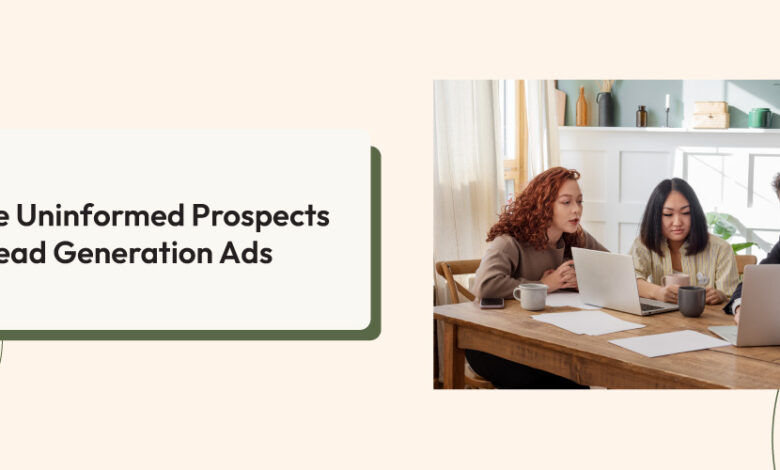Engage Uninformed Prospects With Lead Generation Ads

For small businesses to prosper, their strategies must be budget-friendly and time-saving. How can lead-gen ads be a massive plus?
Marketing is at the center of witnessing fluctuations and evolving trends that keep the market ablaze. When uncertainty looms at every turn, which strategies, including lead generation ads can actually draw in customers?
There is no coherent answer.
Marketing has adopted a trial-and-error method since the olden days- it’s all about experimentation. So, a sure-shot answer to this question doesn’t really exist. The lack introduces a significant divide between strategy mapping and its implementation.
And it’s due to this gap that marketing proves to be overwhelming.
Churning out strategies that actually work can be time-consuming and demanding, especially for small businesses. According to Forbes, small businesses are stuck in a “procrastination loop” with respect to marketing services. Occupied with other responsibilities, they attribute little time to marketing there’s no single rulebook they can leverage, even when considering options like lead generation ads.
Thus, working out a strategy or campaign takes every resource available. Once a strategy fails to work, it is relinquished for the future. It becomes a chore that’s been put off rather than a necessity.
So, how can businesses expect their strategies to churn out the required outcomes this way? It’s nearly impossible.
As the article reports, content creation takes over 50% of the designated time, while managing ad campaigns consumes 19%. The challenge here, then, is the gap in marketing knowledge – which strategies really work, how, and through which marketing channels.
This marketing angst has plagued small business owners.
And the persisting question is: Is there a way out?
With the limited budget and resources, strategic utilization must occupy the first seat. Because market trends transform, but if your roadmaps are agile enough, even if not current, who’s to say it won’t offer results?
The vision should be streamlined- highlighting the relevant marketing goals and then figuring out the go-to approach. For example, if it concerns capturing high-quality leads, what is the best possible digital channel?
For small businesses, the solution is one – lead-generation ads.
Most often, marketers shift their focus onto numbers and forget the real deal – the prospective buyers. Buyers are humans – their highly complex purchasing decisions only come to a halt when they see value in their purchase.
Data alone cannot ensure this. Although the rise of data-driven decision-making is every business leader’s and buyer’s go-to, they are missing something – long-term professional connections and honest conversations.
What about brands like Apple? Apple’s branding is instilled in creating personal connections with its buyers – new and long-term. Every few years, there is a specific intensity of enthusiasm surrounding each new iPhone model.
This is because Apple doesn’t focus merely on engaging new prospects but also retargets existing buyers – those who already own an iPhone. By giving value to prospective and existing customers, Apple has understood that ‘value’ lies at the nucleus of marketing.
It’s the same for small businesses. Data will serve as your knight, but it cannot build your brand from the bottom up. So, how do you ensure you’re making the most of the limited budget and resources in your pocket?
Lead generation ads.
What are lead generation ads?
These ads are personalized display ads that help brands curate targeted ad campaigns.
One of the persistent concerns in lead generation is casting a wide net, which ultimately leads to failure or a minimal outcome. Modern marketers are learning from their predecessors’ mistakes.
They have a spearhead focus when it comes to targeting buyers. Lead generation ads can help boost these efforts as they only consider prospects who click on the brand’s strategically placed ad and complete the form. This is paramount because your business is then focused on leads that actually show intent, even if it’s minute.
With these ads, marketing teams can now collect data such as name, contact details, location, email, age, and gender. The overall purpose is that with these details, the team can get in touch with potential buyers and nurture them, also building a customer base to meet long-term goals.
Before deciding on ad content and placement, consider which section of the marketing funnel and buyer journey you want to target. With lead-generation ads, it’s top of the funnel.
Lead generation ads account for the “first contact” that directs the browser to the brand’s landing page, consisting of a corresponding form. The details are then retrieved to initiate direct communication with the lead.
To surmise, lead gen ads help reach people who are genuinely interested in what your business offers or are actively searching for similar services.
It’s essential to avoid any confusion-
Lead-generation ads inherently differ from conversion ads.
Conversion ads encourage users to take action on an entirely different platform or page. Through this, businesses can control where the leads end up and what actions they should take.
For example, you click on a Facebook ad, and it directs the lead of Facebook to another landing page or website that cites a unique and personalized offer. Your team can decide on the content of the landing page.
Meanwhile, lead generation ads, as exemplified before, technically include clicking on an ad that pops up a form. Leads eventually submit the form with their details, which your brand collects manually or through an automated system.
Pinterest is a noteworthy example, exemplifying how lead ads actually work.
Pinterest users share their information with the party leveraging these services. They fill out the form your lead ad involves without having to leave the website or the app.
With Pinterest, this experience is seamless and balanced. The partnering brand holds the authority to decide the ad content, form description, questions, and other sections. Because the form has to align with the brand requirements and target audience.
Once interested users have submitted the form, Pinterest allows the brands to download these responses through Pinterest Ad Manager, Pinterest API, or even through integration with Zapier and Salesforce.
The crucial thing here is to create a conversion campaign before curating a lead ad. The conversion campaign helps your brand map which type of conversion you want to drive, i.e., the actions you want users to take on your website, whether checkout or signing up.
Conversion campaigns track the type of conversions, the cost per action, and the budget, optimizing the overall spending.
Only after setting up the conversion campaign can your business move on to create the lead ad and the corresponding lead form.
What should be present in the lead form?
- A persuasive call to action, such as a “sign up” button
- Link to your brand’s privacy policy – transparency on how their data will be used
- Mandatory questions or prompts, such as “Email” or “Name”
- A successful completion message after leads have submitted the form
The next steps for successful data retrieval are as follows:
Lead data can be downloaded from the Ads Manager page but only up to a maximum of 30 days. After 30 days, the data will be deleted and never retrieved again.
But only admin-level access will allow any business account to manage and download data.
Pinterest is just one of the many that offer seamless lead generation ad services, apart from LinkedIn, Facebook, X, Google Ads, and Instagram.
Why are lead-gen ads such a huge ordeal, especially for small businesses?
Previously, we talked about offering value. Lead-generation ads remove the online barrier and friction in the buyer’s journey.
When the journey becomes increasingly complicated and turbulent, drop-offs are highly likely and give way to a negative customer experience. So, lead ads generally don’t direct users off the platform but accompany a pop-up. This avoids any hindrance to the user’s browsing experience.
Lead generation ads ensure this journey is smooth and straightforward. Traditional forms are cumbersome- manually filling in information can be really time-consuming. But with the advent of digital innovations, this process is automated.
At least on platforms like LinkedIn. Platforms that pre-populate forms with user data notice less friction and higher conversion rates. This ensures that the data is accurate and complete.
It’s one of the ways brands that leverage lead generation ads offer value to potential leads – through ease of use and efficiency. Value doesn’t have to be retained merely in the content but in the overall journey. Before reaching the destination (purchasing decision), the prospect has to flow through the different stages in the funnel, and any difficulty can deter them.
Lead-generation ads prevent this from happening to your brand. It assures several value-driven benefits for your business:
- By not requiring a proper website to function, lead ads can help small businesses that rely on different social media channels to collect prospect data.
- It speeds up the lead generation process by cutting down the number of steps required for conversion. Additionally, these ads focus merely on a targeted demographic, so any data collected points to a high-quality relevant lead your sales team can pursue.
- As a small business with financial constraints, lead generation ads are a feasible method of collecting lead data and making the initial contact.
However, lead-gen ads aren’t merely about the ad itself. It has to entail the before and after of a prospect’s interaction with an ad. From strategic placement to data retrieval, the nitty-gritty of a lead gen ad strategy is many.
But only 3 main components actually matter.
Curating an effective lead gen ad campaign: The tips.
Curating lead-generation ad campaigns holds unique requirements – from creativity to collaboration. This method is increasingly simple for marketers and small businesses, but particular steps must be calculatedly undertaken:
1. Ask the right prompts/questions
Customized questions help filter prospects and highlight specific information the sales team requires. There has to be a balance. When the questions are correct, the answers are guaranteed to be relevant and streamlined.
2. Leverage A/B and multivariate testing.
Ads require experimentation. Not every initial ad can engage prospects from the get-go, it must undergo corrections and edits in content and placement to actually resonate. Multivariate testing will allow your marketing team to test different ad ideas together and observe which ad generates the required results.
3. Integrate the lead form with a CRM system.
Collecting lead data manually is taxing. So, integrate your lead form with a CRM that collates data automatically and stores it when a visitor clicks on the ad. This way, your team wouldn’t need to download them manually or curate spreadsheets.
Further, it will map each touchpoint, allowing you to build a customer profile and use marketing automation to send them personalized messages. This will deliver a single data source organization-wide, especially for marketing and sales teams.
It’s a trial-and-tested method of successfully engaging your potential buyers and communicating with them. A lot of conventional lead gen methods are determined by their quantity-before-quality approach.
But with lead generation ads? Building relationships becomes smoother when the buyer’s journey begins seamlessly.
Lead-generation ads remove friction and digital barriers.
Small businesses neither have the budget nor the space to focus all their priorities on lead generation. To grow, they require functional and scalable strategies that promise good results.
The effectiveness and scalability of these strategies are rooted in how they are developed and implemented. To ascertain this, the chosen lead-generation model for small businesses should be agile and comprehensive enough to align with the evolving digital landscape.
So, their foolproof way out is lead generation ads.
Executing an effective ad strategy has shifted the focus to prospects and building a seamless experience for them. It’s not merely about accurate data and ROI but value-driven offerings.
Hence, the objective is to reduce friction and facilitate ease of use. And the most effective way to deliver it? Lead generation ads.
https://ciente.io/wp-content/uploads/2025/04/Engage-Uninformed-Prospects-With-Lead-Generation-Ads-website.jpg
2025-04-04 11:40:14




